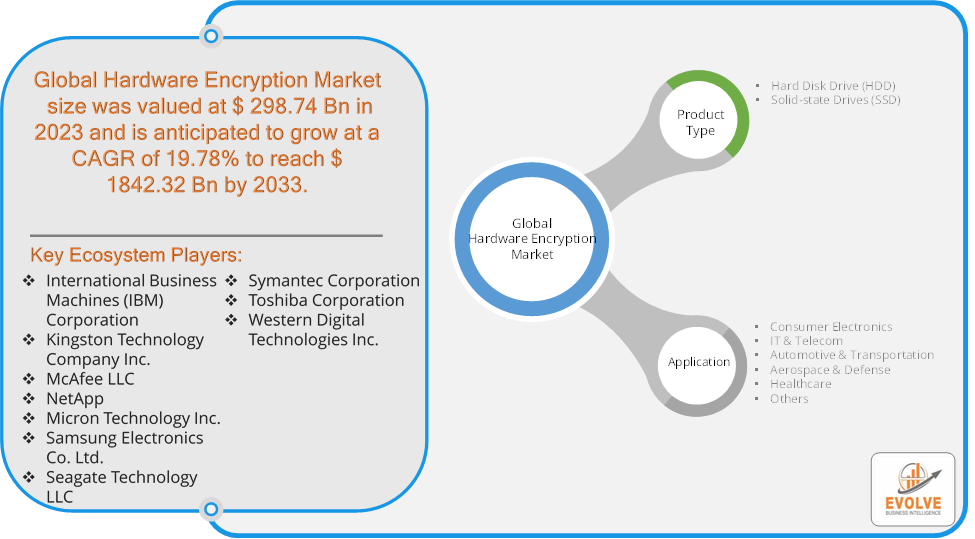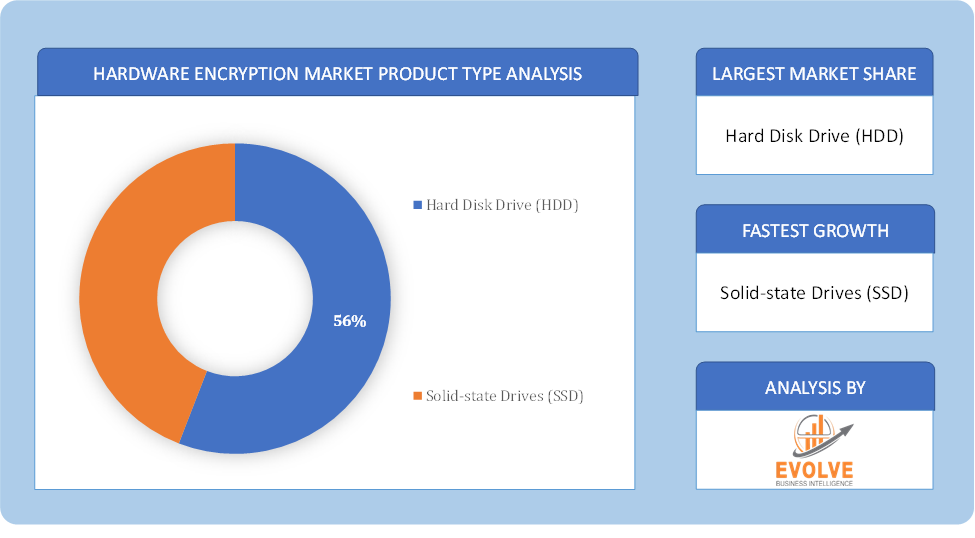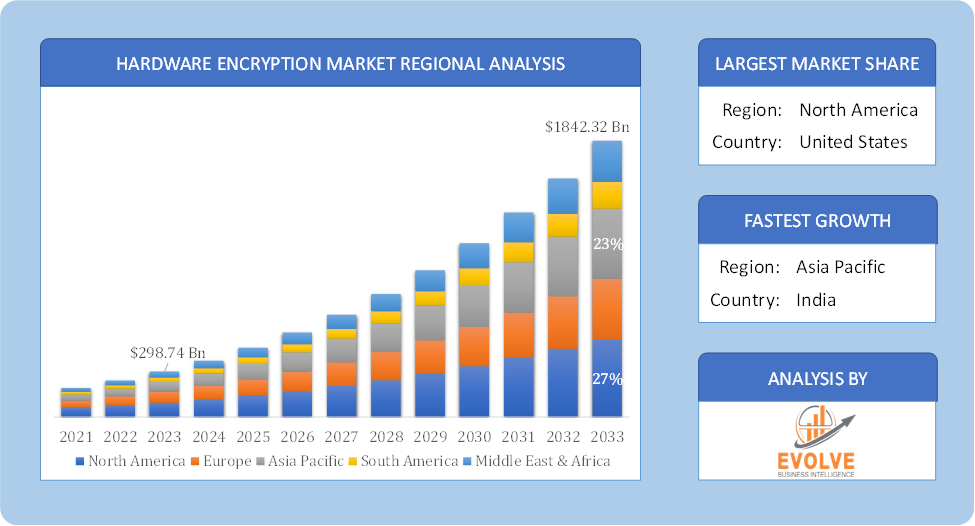Hardware Encryption Market Overview
The Hardware Encryption Market Size is expected to reach USD 1842.32 Billion by 2033. The Hardware Encryption Market industry size accounted for USD 298.74 Billion in 2023 and is expected to expand at a compound annual growth rate (CAGR) of 19.78% from 2023 to 2033. The Hardware Encryption Market refers to the market for devices and solutions that provide encryption at the hardware level, rather than through software alone. Hardware encryption involves using a dedicated processor or chipset to perform cryptographic operations such as encryption and decryption of data. This approach is often more secure and faster than software-based encryption because it is less susceptible to external threats like malware or hacking.
The market is driven by increasing concerns over data breaches, stringent regulatory requirements, and the growing adoption of cloud computing and IoT devices, which demand robust security measures.
Global Hardware Encryption Market Synopsis
The COVID-19 pandemic had a significant impact on the Hardware Encryption Market. The rapid shift to remote work environments increased the risk of data breaches and cyberattacks. Organizations sought to enhance data security for remote workers, driving the demand for hardware encryption solutions to secure sensitive information stored on devices outside the corporate network. With more consumers and businesses relying on online transactions during the pandemic, there was a heightened need for secure payment methods. This spurred demand for hardware encryption in sectors like banking and e-commerce to protect transaction data. The global supply chain disruptions caused by lockdowns and restrictions led to shortages of critical components used in hardware encryption devices, such as semiconductors and integrated circuits. This affected the production and availability of hardware encryption products. The pandemic accelerated digital transformation initiatives across various industries. As organizations adopted new digital tools and platforms, the need for robust encryption, including hardware-based solutions, became more pronounced to ensure the security of digital assets.
Hardware Encryption Market Dynamics
The major factors that have impacted the growth of Hardware Encryption Market are as follows:
Drivers:
Ø Growth of Digital Transactions and Online Activities
The increasing reliance on digital platforms for transactions, communication, and data storage has created a demand for secure encryption solutions. Sectors like banking, e-commerce, and healthcare, which handle vast amounts of sensitive data, are particularly focused on implementing hardware encryption to secure their digital operations. Continuous advancements in encryption technology, including faster and more efficient encryption algorithms and the development of dedicated encryption hardware, are driving the adoption of hardware encryption solutions. These advancements make hardware encryption more accessible and cost-effective for organizations of all sizes.
Restraint:
- Perception of High Initial Costs and Complex Integration
Implementing hardware encryption solutions often requires significant upfront investment in specialized hardware, such as encrypted drives, hardware security modules (HSMs), and encryption-enabled devices. For small and medium-sized enterprises (SMEs) with limited budgets, these costs can be prohibitive, leading to slower adoption rates. Integrating hardware encryption into existing IT infrastructure can be complex and time-consuming. The need for specialized knowledge and expertise to deploy and manage hardware encryption solutions may deter organizations, particularly those with limited IT resources, from adopting these technologies.
Opportunity:
⮚ Growing Demand for Data Privacy
Increasing concerns about data privacy and security are driving the need for robust encryption solutions. As organizations and individuals become more aware of data breaches and privacy violations, the demand for hardware-based encryption solutions is expected to rise, presenting opportunities for market expansion. Heightened awareness about cybersecurity risks and regulatory compliance is prompting organizations to invest in advanced security measures. Companies looking to enhance their security posture are increasingly adopting hardware encryption solutions to protect sensitive data and meet regulatory requirements.
Hardware Encryption Market Segment Overview
Based on Product Type, the market is segmented based on Hard Disk Drive (HDD) and Solid-state Drives (SSD). The HDD Encryption segment dominant the market. This is mainly due to the widespread use of hard disk drives in various devices, including desktop computers, laptops, servers, and data centers. HDD encryption solutions are widely used to safeguard sensitive data stored on these devices, ensuring data confidentiality and adherence to data protection regulations.
By Application
Based on Application, the market segment has been divided into Consumer Electronics, IT & Telecom, Automotive & Transportation, Aerospace & Defense, Healthcare and Others. The automotive and transportation segment dominant the market. Automotive and transportation users can use hardware encryption to safeguard vehicle data, navigation systems, driver profiles, and diagnostics against cyber threats, unauthorized access, and remote exploitation.
Global Hardware Encryption Market Regional Analysis
Based on region, the global Hardware Encryption Market has been divided into North America, Europe, Asia-Pacific, the Middle East & Africa, and Latin America. North America is projected to dominate the use of the Hardware Encryption Market followed by the Asia-Pacific and Europe regions.
 Hardware Encryption North America Market
Hardware Encryption North America Market
North America holds a dominant position in the Hardware Encryption Market. This region is a major player in the hardware encryption market, driven by the presence of large enterprises, government agencies, and financial institutions. The United States and Canada are key contributors to the market’s growth. North America, particularly the United States and Canada, is a major market for hardware encryption due to the high level of digital transformation, advanced IT infrastructure, and stringent data protection regulations such as GDPR and CCPA.
Hardware Encryption Asia-Pacific Market
The Asia-Pacific region has indeed emerged as the fastest-growing market for the Hardware Encryption Market industry. The Asia-Pacific region is experiencing rapid growth in the hardware encryption market due to increasing digitalization, the rise of IoT devices, and growing concerns about data security. This region is experiencing rapid growth in the hardware encryption market, primarily due to the increasing adoption of digital technologies and the expansion of IT infrastructure. China, India, Japan, and South Korea are key markets in the Asia Pacific region.
Competitive Landscape
The global Hardware Encryption Market is highly competitive, with numerous players offering a wide range of software solutions. The competitive landscape is characterized by the presence of established companies, as well as emerging startups and niche players. To increase their market position and attract a wide consumer base, the businesses are employing various strategies, such as product launches, and strategic alliances.
Prominent Players:
- International Business Machines (IBM) Corporation
- Kingston Technology Company Inc.
- McAfee LLC
- NetApp
- Micron Technology Inc.
- Samsung Electronics Co. Ltd.
- Seagate Technology LLC
- Symantec Corporation
- Toshiba Corporation
- Western Digital Technologies Inc.
Key Development
In Mar-2024, Samsung Electronics Co., Ltd. introduced the Galaxy A55 5G and Galaxy A35 5G. The new products boast remarkable photography capabilities, synonymous with the Samsung Galaxy brand. They include advanced features like optical image stabilization (OIS) and video digital image stabilization (VDIS), ensuring that photos and videos remain sharp and steady even when captured on the move.
Scope of the Report
Global Hardware Encryption Market, by Product Type
- Hard Disk Drive (HDD)
- Solid-state Drives (SSD)
Global Hardware Encryption Market, by Application
- Consumer Electronics
- IT & Telecom
- Automotive & Transportation
- Aerospace & Defense
- Healthcare
- Others
Global Hardware Encryption Market, by Region
- North America
- US
- Canada
- Mexico
- Europe
- UK
- Germany
- France
- Italy
- Spain
- Benelux
- Nordic
- Rest of Europe
- Asia Pacific
- China
- Japan
- South Korea
- Indonesia
- Austalia
- Malaysia
- India
- Rest of Asia Pacific
- South America
- Brazil
- Argentina
- Rest of South America
- Middle East & Africa
- Saudi Arabia
- UAE
- Egypt
- South Africa
- Rest of Middle East & Africa
| Parameters | Indicators |
|---|---|
| Market Size | 2033: USD 1842.32 Billion |
| CAGR (2023-2033) | 19.78% |
| Base year | 2022 |
| Forecast Period | 2023-2033 |
| Historical Data | 2021 (2017 to 2020 On Demand) |
| Report Coverage | Revenue Forecast, Competitive Landscape, Growth Factors, and Trends |
| Key Segmentations | Product Type, Application |
| Geographies Covered | North America, Europe, Asia-Pacific, South America, Middle East, Africa |
| Key Vendors | International Business Machines (IBM) Corporation, Kingston Technology Company, Inc., McAfee, LLC, NetApp, Micron Technology, Inc., Samsung Electronics Co., Ltd., Seagate Technology LLC, Symantec Corporation, Toshiba Corporation and Western Digital Technologies, Inc. |
| Key Market Opportunities | · Growing Demand for Data Privacy
· Rising Cybersecurity Awareness |
| Key Market Drivers | · Growth of Digital Transactions and Online Activities
· Technological Advancements in Encryption Technology |
REPORT CONTENT BRIEF:
- High-level analysis of the current and future Hardware Encryption Market trends and opportunities
- Detailed analysis of current market drivers, restraining factors, and opportunities in the future
- Hardware Encryption Market historical market size for the year 2021, and forecast from 2023 to 2033
- Hardware Encryption Market share analysis at each product level
- Competitor analysis with detailed insight into its product segment, Government & Defense strength, and strategies adopted.
- Identifies key strategies adopted including product launches and developments, mergers and acquisitions, joint ventures, collaborations, and partnerships as well as funding taken and investment done, among others.
- To identify and understand the various factors involved in the global Hardware Encryption Market affected by the pandemic
- To provide a detailed insight into the major companies operating in the market. The profiling will include the Government & Defense health of the company’s past 2-3 years with segmental and regional revenue breakup, product offering, recent developments, SWOT analysis, and key strategies.










